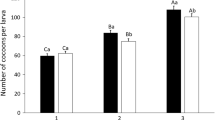Abstract
Biological control ofstalkboring Lepidoptera often has beensuccessful when the braconid parasitoids in thegenera Cotesia and Apanteles werethe natural enemies of choice. Constraints inusing these gregarious, koinobiont,endoparasitoids have included host suitability,especially as influenced by the host's immuneresponse. The suitability of a novel host, theNew World stalkborer Diatraeaconsiderata (Lepidoptera:Pyralidae), for parasitization by three OldWorld braconids, Cotesia chilonis, C. flavipes and C. sesamiae (Hymenoptera: Braconidae), wascompared to the suitability of another NewWorld novel host, Diatraea saccharalis. D. considerata was less suitable for allthree parasitoids than was D.saccharalis. The frequent occurrence ofparasitized D. considerata larvae thatdid not yield parasitoids, or pupate within anappropriate time interval, suggestedencapsulation of the parasitoid progeny, whichwas visible through the host cuticle. Giventhe suitability results, these threeparasitoids would not be appropriate candidatesfor use against D. considerata. Theresults also have important implications forthe narrow host range expressed by theseparasitoids.
Similar content being viewed by others
References
Alam, M.M., F.D. Bennett and K.P. Carl, 1971. Biological control of Diatraea saccharalis in Barbados by Apanteles flavipes Cam. and Lixophaga diatraeae T.T. Entomophaga 16: 151–158.
Alleyne, M. and R.N. Wiedenmann, 2001a. Suitability of lepidopteran stemborers for parasitization by novel-association endoparasitoids. BioControl 46: 1–23.
Alleyne, M. and R.N. Wiedenmann, 2001b. Encapsulation and hemocyte numbers in three lepidopteran stemborers parasitized by Cotesia flavipes-complex parasitoids. Entomologia Experimentalis et Applicata 100: 279–293.
Austin, A.D. and P.C. Dangerfield, 1989. The taxonomy of the New World microgastrine (Hymenoptera: Braconidae) parasitic on Diatraea spp. (Lepidoptera: Pyralidae). Bull. Entomol. Res. 79: 131–144.
Bennett, F.D., 1965. Tests with parasites of Asian graminaceous moth-borers on Diatraea and allied genera. Commonw. Inst. Bio. Control Tech. Bull. 5: 101–116.
Box, H.E., 1951. Informe preliminar sobre los barrenadores o “borers” de la caña de azucar (Diatraea, Chilo) en Mexico, a base de un viaje de reconocimiento efectuado durante Marzo–Abril, 1951, a las regiones cañeras: I Sinaloa, II Nayarit y XIV Huastecas, con observaciones complementarias. Union Nacional Productores Azucar. Mexico, D. F.
Fuchs, T.W., F.R. Huffman and J.W. Smith, Jr., 1979. Introduction and establishment of Apanteles flavipes (Hym.: Braconidae) on Diatraea saccharalis (Lep.:Pyralidae) in Texas. Entomophaga 24: 109–114.
Hokkanen, H.M.T. and D. Pimentel, 1984. New approach for selecting biocontrol agents. Can. Entomol. 116: 1109–1121.
Kajita, H. and F.E. Drake, 1969. Biology of Apanteles chilonis and A. flavipes (Hymenoptera: Braconidae), parasites of Chilo suppressalis. Mushi 42: 163–179.
Martinez, A.J., J. Bard and T. Holler, 1988. Mass rearing sugarcane borer and Mexican rice borer for production of parasites Allorhogas pyralophagus and Rhaconotus roslinensis. USDA-APHIS 83-1.
Meagher, R.L., Jr., J.W. Smith, Jr., H.W. Browning and R.R. Saldaña, 1998. Sugarcane stemborers and their parasites in southern Texas. Environ. Entomol. 27: 759–766.
Ngi-Song, A.J., W.A. Overholt, P.G.N. Njagi, M. Dicke, J.N. Ayertey and W. Lwande, 1996. Volatile infochemicals used in host and host habitat location by Cotesia flavipes Cameron and Cotesia sesamiae (Cameron) (Hymenoptera: Braconidae), larval parasitoids of stemborers on graminae. J. Chem. Ecology 22: 307–323.
Ngi-Song, A.J., W.A. Overholt, J.W. Smith, Jr. and S.B. Vinson, 1999. Suitability of new and old association hosts for the development of selected microgastrine parasitoids of gramineous stemborers. Entomologia Experimentalis et Applicata 90: 257–266.
Overholt, W.A., 1998. Biological control. In: A. Polaszek (ed), African cereal stemborers: economic importance, taxonomy, natural enemies and control. CAB International, Wallingford, Oxon, UK. pp. 349–404.
Overholt, W.A. and J.W. Smith, Jr., 1990. Colonization of six exotic parasites (Hymenoptera) against Diatraea grandiosella (Lepidoptera: Pyralidae) in corn. Environ. Entomol. 19: 1889–1902.
Rodriguez-del-Bosque, L.A. and J.W. Smith, Jr., 1989. Exploration for parasites of sugarcane stalkborers (Lepidoptera: Pyralidae) in Michoacan and Jalisco, Mexico, 1988. Tex. Agr. Exp. Sta. Prog. Rep. 4672.
Rodriguez-del-Bosque, L.A. and J.W. Smith, Jr., 1997. Biological control of maize and sugarcane stemborers in Mexico: a review. Insect Sci. Applic. 17: 305–314.
Rodriguez-del-Bosque, L.A., H.W. Browning and J.W. Smith, Jr., 1990. Seasonal parasitism of cornstalk borers (Lepidoptera: Pyralidae) by indigenous and introduced parasites in northeastern Mexico. Environ. Entomol. 19: 393–402.
SAS Institute, 1985. User's guide: statistics. SAS Institute, Cary, NC.
Simmonds, F.J., 1972. Approaches to biological control problems. Entomophaga 17: 251–264.
Smith, J.W., Jr. and L.A. Rodriguez-del-Bosque, 1994. New distribution and host-range records for Apanteles deplanatus (Hymenoptera: Braconidae), a parasite of Diatraea considerate and D. magnifactella (Lepidoptera: Pyralidae), in Mexico. Biol. Control 4: 249–253.
Smith, J.W., Jr. and R.N. Wiedenmann, 1997. Foraging strategies of stemborer parasites and their application to biological control. Insect Sci. Applic. 17: 37–49.
Smith, J.W., Jr., R.N. Wiedenmann and W.A. Overholt, 1993. Parasites of lepidopteran stemborers of tropical gramineous plants. ICIPE Science Press, Nairobi.
Van Leerdam, M.B., J.W. Smith, Jr. and T.W. Fuchs, 1985. Frass-mediated, host finding behavior of Cotesia flavipes, a braconid parasite of Diatraea saccharalis (Lepidoptera: Pyralidae). Ann. Entomol. Soc. Am. 78: 647–650.
Wiedenmann, R.N. and J.W. Smith, Jr., 1995. Parasitization of Diatraea saccharalis (Lepidoptera: Pyralidae) by Cotesia flavipes (Hymenoptera: Braconidae). Environ. Entomol. 24: 950–961.
Wiedenmann, R.N. and J.W. Smith, Jr., 1997. Novel associations and importation biological control: the need for ecological and physiological equivalencies. Insect Sci. Applic. 17: 51–60.
Wiedenmann, R.N. and J.W. Smith, Jr., 1999. Using novel host-parasitoid associations for biological control of native pests. In: L.D. Charlet and G.J. Brewer (eds), Biological control of native or indigenous insect pests: challenges, constraints, and potential. Proc. Thomas Say Pub Entomol., Lanham, MD. USA. pp. 16–37.
Wiedenmann, R.N., J.W. Smith, Jr. and P.O. Darnell, 1992. Laboratory rearing and biology of the parasite Cotesia flavipes (Hymenoptera: Braconidae) using Diatraea saccharalis (Lepidoptera: Pyralidae) as a host. Environ. Entomol. 21: 1160–1167.
Author information
Authors and Affiliations
Rights and permissions
About this article
Cite this article
Wiedenmann, R.N., Smith, J. & Rodriguez-del-Bosque, L.A. Host suitability of the New World stalkborer Diatraea considerata for three Old World Cotesia parasitoids. BioControl 48, 659–669 (2003). https://doi.org/10.1023/A:1026368013414
Issue Date:
DOI: https://doi.org/10.1023/A:1026368013414




